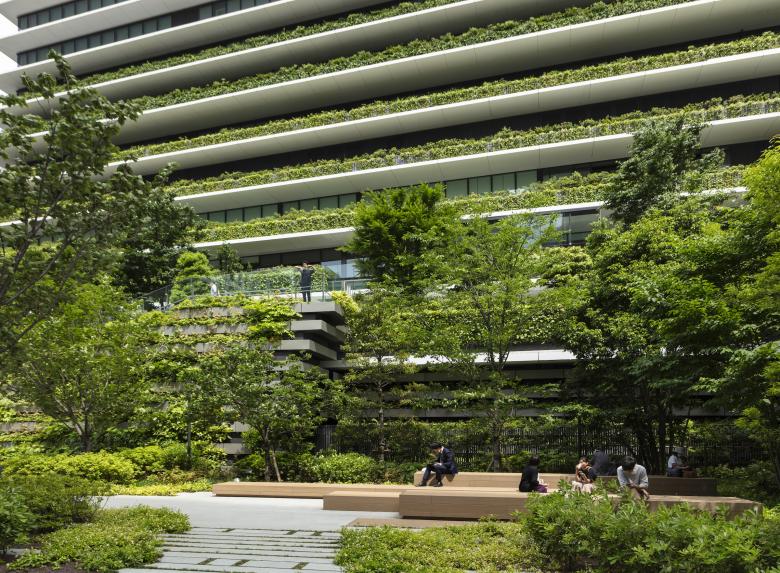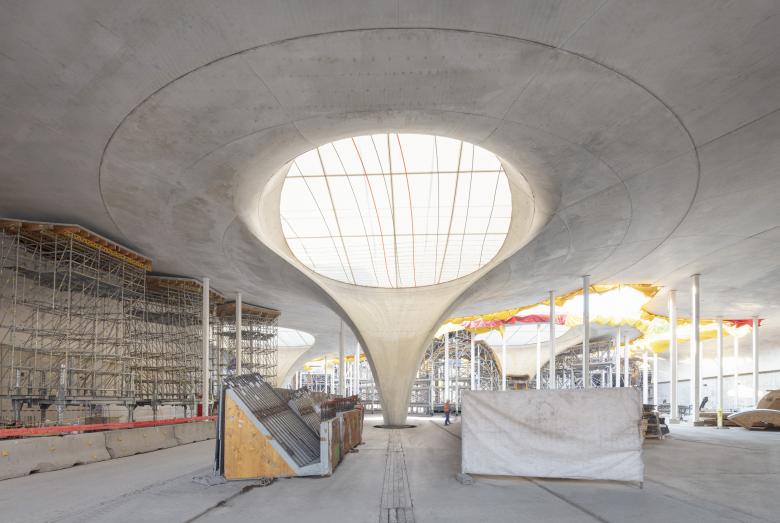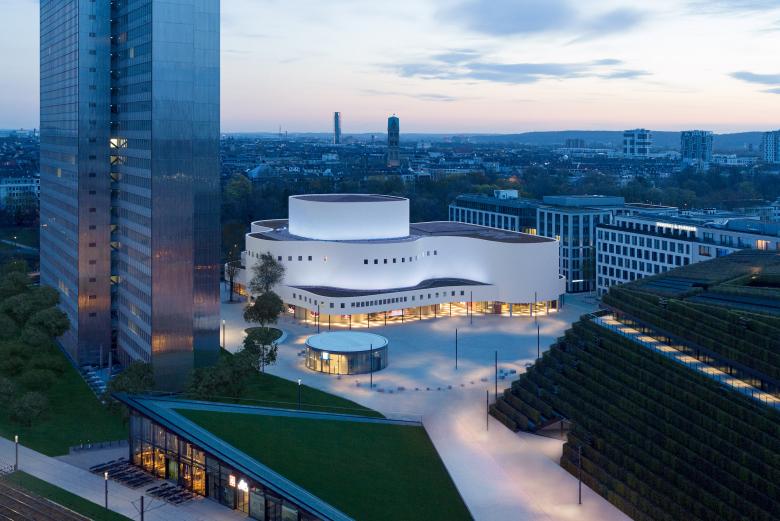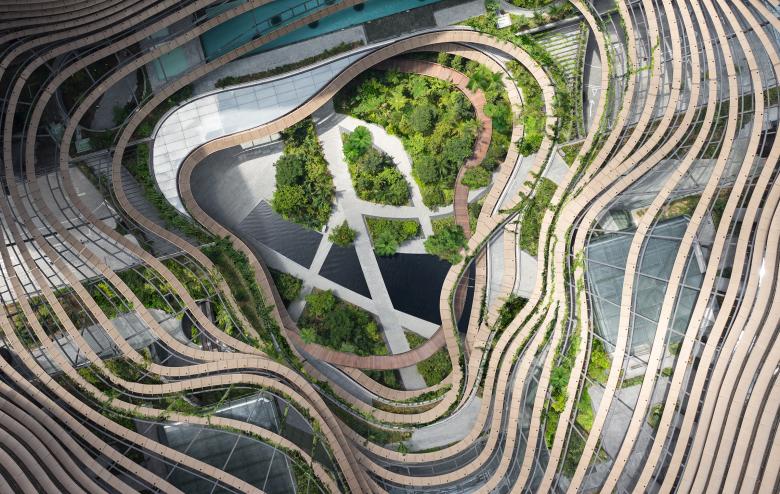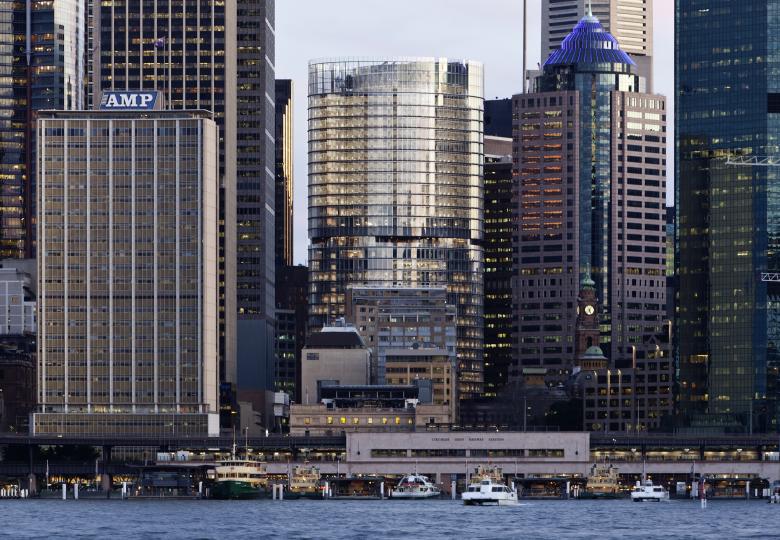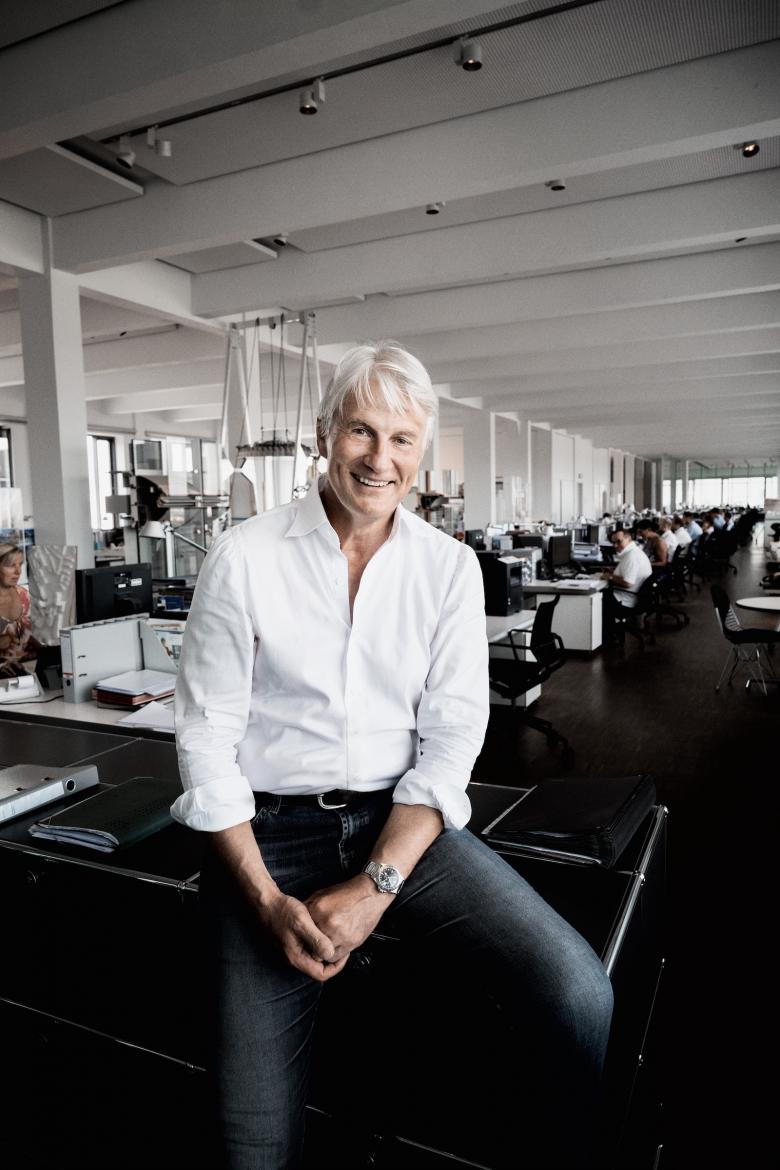Interview with Christoph Ingenhoven
'The world can learn from its diversity'
In Vladimir Belogolovsky’s interview with Christoph Ingenhoven, the architect talks about learning from his professors in Aachen and Düsseldorf, his decision not to go into an architectural partnership with his father, and trying to incorporate every progressive and sustainable idea into his buildings.
Düsseldorf architect Christoph Ingenhoven (b. 1960) does not believe in today’s need for a German national architecture — or any national architecture for that matter. Instead, he is convinced of the urgency in attracting different talents to work together anywhere in the world. It is therefore quite apt that the architect’s talent and expertise are in demand seemingly everywhere. Distant from Ingenhoven’s home country, his portfolio of built works includes Toranomon Hills Tower, with its characteristic hanging gardens (Tokyo, 2022); Marina One, a mixed-use high-rise complex with a striking green oasis (Singapore, 2018); Mapletree Bay Point Hong Kong office high-rise with a landscaped roof garden (Hong Kong, 2018); and 1 Bligh, Australia’s first green skyscraper (Sydney, 2011).
All of the above-mentioned projects Ingenhoven’s eponymous firm won in international competitions. In fact, these competitions have largely defined his successful career. His first invitation to participate in a competition, for the Bundespost building in Cologne, was the impetus to open his practice in 1985. Another one, for the design and construction of the RWE Headquarters in Essen, led to his first completed building in 1997. It was also in 1997 that his office won a huge international competition to design Stuttgart Main Station. A quarter of a century later this sprawling underground structure, one of the biggest infrastructure projects in Europe, is now being finished.
Christoph Ingenhoven (CI): My father had a very small practice, working as a solo practitioner from when I was about nine or ten; his studio was at our house. I still have vivid memories of some of the plans he worked on. He appreciated my interest in his work. Later, he had an office with a small team within walking distance of our home. Two places where I spent much of my adolescence were the tennis court and my father’s office. I assisted him as a draftsman before going to university. And I worked for him on and off as a college student. His portfolio included department stores, a car showroom, a theater, and a city hall. The buildings he designed were beautiful with clear lines — very contemporary in spirit, influenced by Postmodernism, which was in the air then.
Once I graduated in 1984, I decided not to go into partnership with my father, which was a difficult decision. I wanted to be independent and free of restrictions. Luckily, my younger brother also became an architect, so he joined my father and took over the practice after he passed away. Unfortunately, small practices face big challenges here in Germany. So, he eventually closed his studio and came to work for my company. My younger sister is also part of my team.
CI: Our university was indeed technically oriented. Besides architecture, there were the departments of electrical engineering, mechanical engineering, automobile design and engineering, aerodynamics, and so on. When I started in 1978, it was all about following Mies, Le Corbusier, and Gropius. But within months of my being there, people like Hans Hollein, Robert Stern, Stanley Tigerman, Michael Graves, Charles Moore, and James Stirling had joined the faculty with a very different approach to architecture. Postmodernism changed everything — anything was possible. Curiously, drawings became more important than the buildings themselves. Drawings were viewed as an art form in themselves. Luckily, I was a talented drafter, and I produced quite intricate drawings that made my projects stand out and brought attention to my work within the university.
Before graduating from the university in Aachen I studied at the Academy of Arts in Düsseldorf under Hollein and Stirling. Düsseldorf had a master class system with tiny groups — four to six students, no more than eight. There were no lectures, only critiques, which were incredibly constructive. I learned a lot from both architects, but I think Hollein influenced my work more. He was very experimental but also pragmatic and realistic. He urged us not to make drawings more beautiful than needed; it was not about enhancing ideas but helping to build a building. He encouraged us to think about the building itself, not its representation. Hollein was a thinker, and he challenged us to think. To be honest, he may have even been a better thinker than an architect. He was also against following a routine and instead sought to do new things in new ways. His aim was to do architecture differently — and he did. Just look at the designs of his shops and museums. Although he did not build many buildings, the ones that he did were all very experimental and unexpected.
CI: I had to report to military service right after getting my degree, and after that I had to take my licensing exam. What launched my practice was a competition. I was contacted by a friend who worked for the former Deutsche Bundespost, which in those days was a huge state-run business comprising Deutsche Post AG (postal service), Deutsche Telekom (telecommunications), and Deutsche Postbank AG (government bank). They were later split into three different companies and privatized. This friend invited me to take part in an anonymous competition for a Bundespost building in Cologne. I took a leap in accepting the challenge because I was still unlicensed, with no staff and no office. I contacted three former classmates from Aachen and convinced them to work with me for a few months. And we won! Being invited into the competition was a surprise, and so was winning. Our competitors were major well-known firms, including Gottfried Böhm, who had just won the Pritzker Prize. Yet, I was the one who won — the outsider.
CI: The project was quite large and complex, an ensemble of buildings and volumes. I was commissioned for this enormous job even though I had no real building experience, nothing on that scale. But that wasn’t the issue; the project was never built because the company was split into three divisions a year later, and they didn’t want to be in the same building anymore. Then I was hired by the German Telecom division for a much smaller project. But that wasn’t built either. [Laughs.] Why? Well, it was expensive, and it was the late 1980s, when everyone was still recovering from the global recession. Ultimately, after a couple of years of collaborating to develop the project, we parted ways, as they decided to develop their project in-house. For me personally, at least financially and in terms of my visibility, it was still a great success. Soon, other projects followed. A few years later, I participated in a competition that didn’t lead to construction but to another competition, which resulted in a commission that wasn’t built either. Two more competitions followed, both of which I won. One of them, finally, led to my first completed building.
CI: Yes, we won the first competition, and we shared first prize in the second one with Foster + Partners. We received the news that we won both competitions in the same week. The Essen project went ahead, while the bank went with Foster.
CI: It was. Initially, it was going to be a much bigger project with several buildings. But as it developed, some of the buildings went to other architects. In the end, I was asked to develop only one tower. It was not until two or three years later that the client found out this tower was in fact my very first completed building. [Laughs.] We already had the infrastructure, staff, and everything else you need to complete projects — I just hadn’t had the opportunity until then. In any case, the client was pleased with the result.
We incorporated every idea we found interesting and progressive into that building. It was unlike anything you would expect in a typical high-rise at the time. For inspiration, we looked at various structures built 30 to 40 years earlier. And we had a great team. Frei Otto was on board as a consultant, and he questioned everything, considering every possible angle. We compiled a long list of what we found annoying about high-rises: repetitive floors, being sealed from the environment, no flexible climate control, no connections between floors, no spatial qualities, no open atriums, no sense of community, etc. We wanted to change all of those issues. So, we opened everything from the ground floor up. We had a garden and glass elevators on the outside. We introduced a double-skin facade with sunshades between the layers that users could fully control. There was natural ventilation whenever they wanted. There were open ceilings, reliance on concrete thermal mass, natural airflow within the facade, etc. Having so much innovation in a single building was very unusual then. I visit the building often. It is very well maintained, and the people who use it are very proud of it.
CI: I am not sure there is such a thing anymore. There are now too many currents and movements. And many architects these days are fairly conservative. There is a lot of talk about finding the appropriate style — a topic that I think is irrelevant and obsolete. The world is much too diverse for that. Instead of talking about national architecture, I would rather talk about Europe overall, which has great diversity, and when we compete, it’s healthy because it sparks innovation. Germany had its role with the Bauhaus, and our leading architects helped to meet our society’s demand for growing both vertically and horizontally. But after both World Wars, Germany became very self-critical, overtaken by German angst in the form of fear of change. Being cautious slows innovation. Do we still have German architecture? No. I think it’s provincial even to want that. The world can’t learn anything from that. The world can learn from its diversity, which can happen anywhere. We need to attract different talents from around the world to work together. Universities in the United States do that well; more of us should do that.
